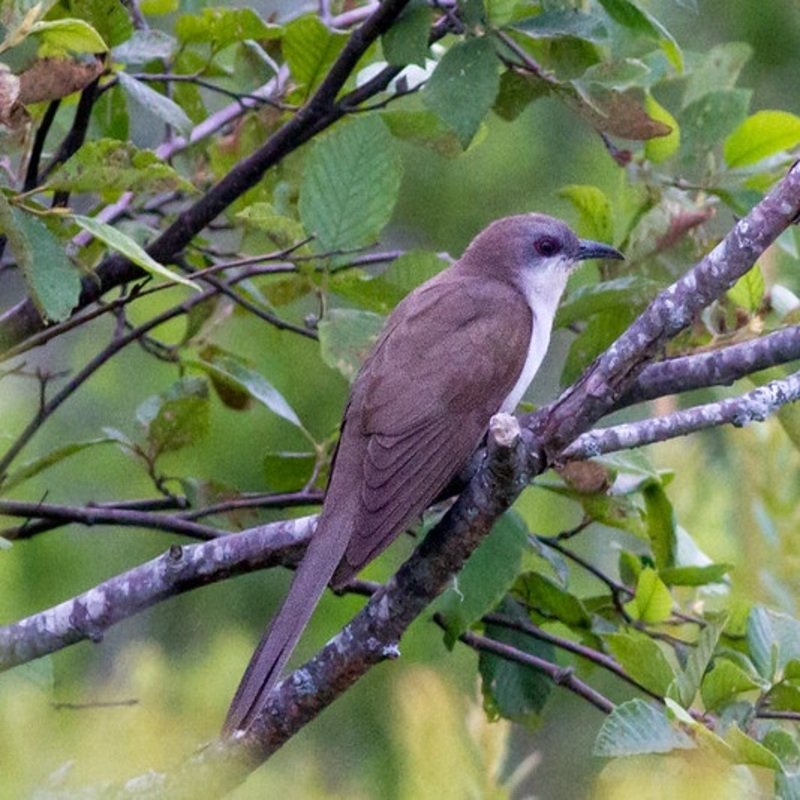The black-billed cuckoo (Coccyzus erythropthalmus) is a New World cuculid. The scientific name is Greek. The name erythropthalmus comes from the Greek words eruthros, “red”, and ophthalmos, “eye”. Its distribution overlaps with the yellow-billed cuckoo. Cuculidae deposit eggs in other birds’ nests. However, C. erythropthalmus regularly incubates their own chicks.
Quick Overview: Coccyzus Erythropthalmus – Black-Billed Cuckoo
Body size: Around 11-12 in (28-30 cm) and a weight of 102 g (3.6 oz)
Main colors: Gray-brown, White, Black, Red, Brown
Range: Southeastern United States
Migratory Bird: Yes
Best time of the year to see in the U.S.: June, July, August, September
Conservation Status: Least Concern
Black-Billed Cuckoo Description
Black-billed cuckoos have long tails and thin bodies. The head and body are grayish-brown, while the underside is white. The bill is dark and curved. The eyes of adult black-billed cuckoos are reddish. The juveniles have a golden or buff eye-ring. Juveniles have a creamier white underside and rusty-brown wingtips. Female black-billed cuckoos are bigger than males. Yellow-billed cuckoos have a similar body form and color to black-billed cuckoos.

Size
These birds have a length of 11-12 in (28-30 cm) and a weight of 102 g (3.6 oz). Their wings could range from 15-17 in (38-43 cm).
Feeding
Caterpillars, cicadas, katydids, butterflies, grasshoppers, and crickets are favorite foods of black-billed cuckoos. They devour other birds’ eggs and aquatic larvae and fish. In the summer, they eat fruits and seeds. Beetles stink bugs, snails, and dragonflies are among the other foods.
Habitat
Black-billed cuckoos inhabit forests and marshes. They like deciduous woods with orchards and thickets, and environments near water, such as rivers, streams, and lakes. Black-billed cuckoos have been seen in parks and golf courses in cities and suburbs.
Behavior
Black-billed cuckoos seldom hop. When they do, they walk silently and in a three-beat rhythm. Black-billed cuckoos soar. They stretch their wings to dry after a downpour. They are probably territorial, but no clear proof of this has been documented. Black-billed cuckoos are territorial and may dive and hunt other cuckoos away from the nest.
Coccyzus Erythropthalmus Scientific Classification
- Kingdom: Animalia
- Phylum: Chordata
- Subphylum: Chelicerata
- Class: Aves
- Order: Cuculiformes
- Family: Cuculidae
- Genus: Coccyzus
- Species: Coccyzus erythrophalmus
Best time of the year to see
The best time to see these birds in the United States is during the summer season (June – September).
Distribution of the Black-Billed Cuckoo in the USA
Neotropical black-billed cuckoos inhabit the Neartic. From the east coast to Oklahoma, west to Montana, and north to Canada. These cuckoos move to northern South America, particularly Venezuela, Columbia, and central Bolivia, during the non-breeding season. These birds move across tropical forests, cloud forests, and dry scrub habitats in the southeastern US and Mexico.
The Black-Billed Cuckoo can be found in the following states in the United States – Alabama, Arkansas, Connecticut, Delaware, Florida, Georgia, Hawaii, Illinois, Indiana, Iowa, Kansas, Kentucky, Louisiana, Maine, Maryland, Massachusetts, Michigan, Minnesota, Mississippi, Missouri, Nebraska, New Hampshire, New Jersey, New York, North Carolina, North Dakota, Ohio, Pennsylvania, Rhode Island, South Carolina, South Dakota, Tennessee, Vermont, Virginia, West Virginia, and Wisconsin.

